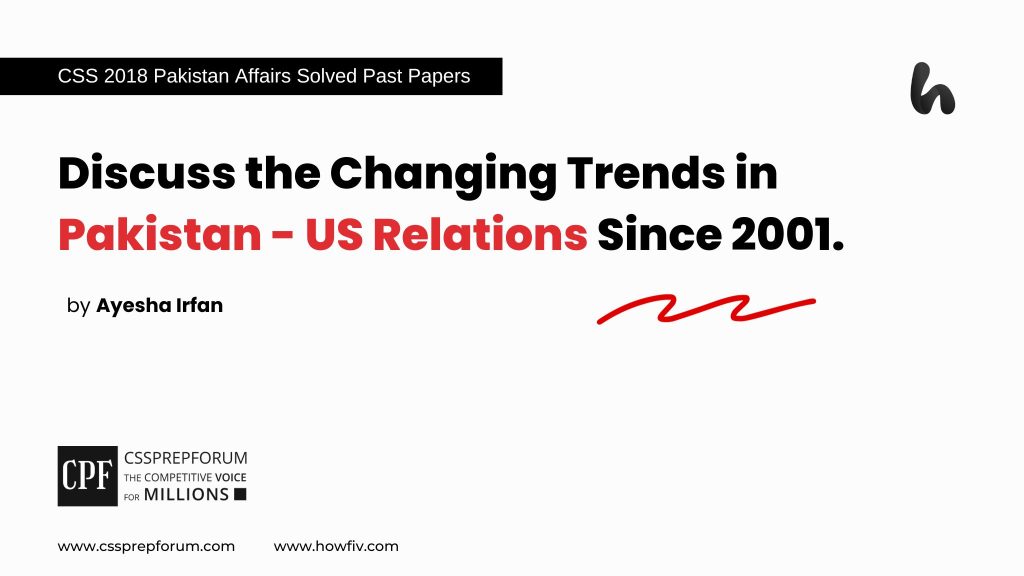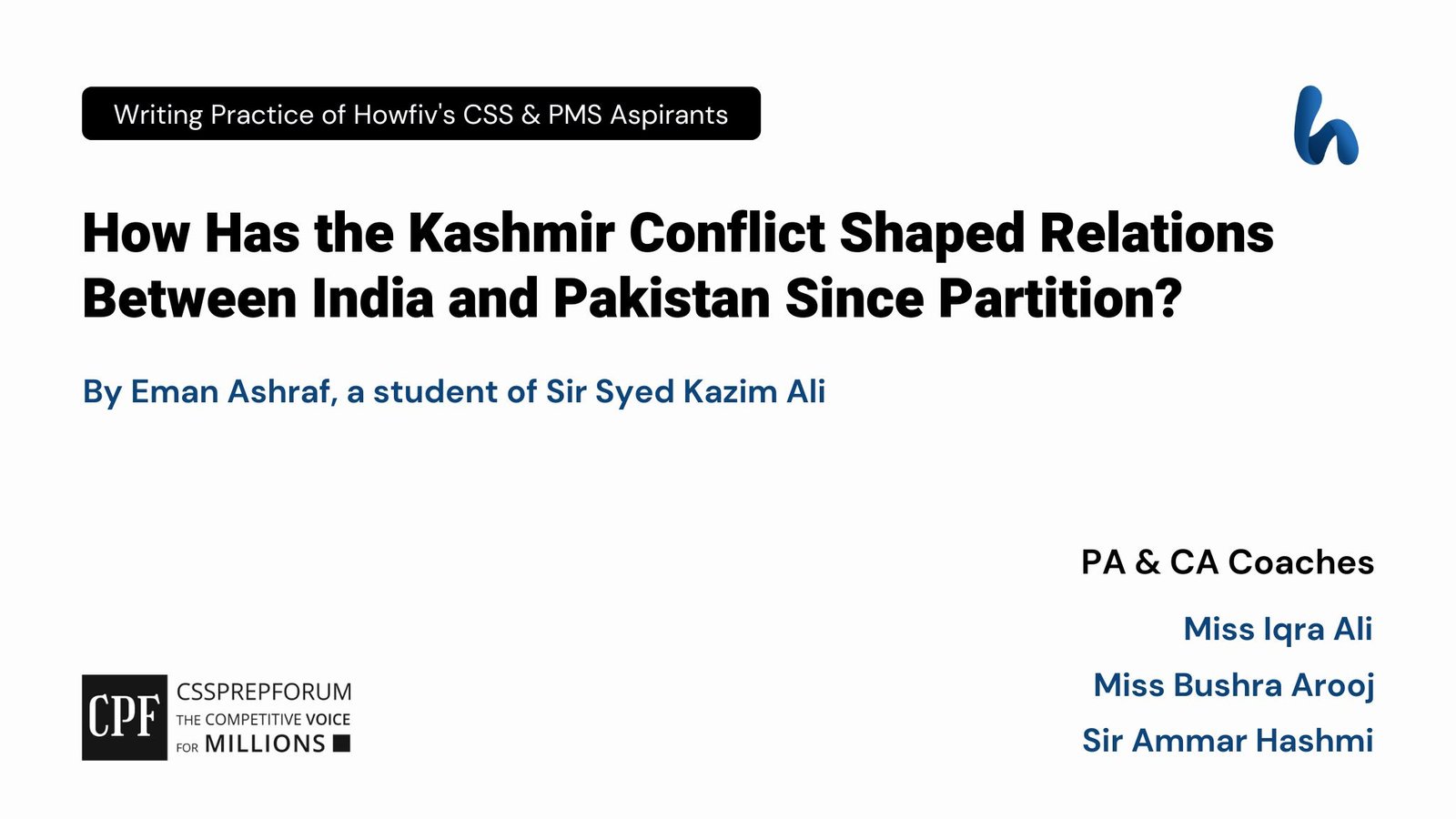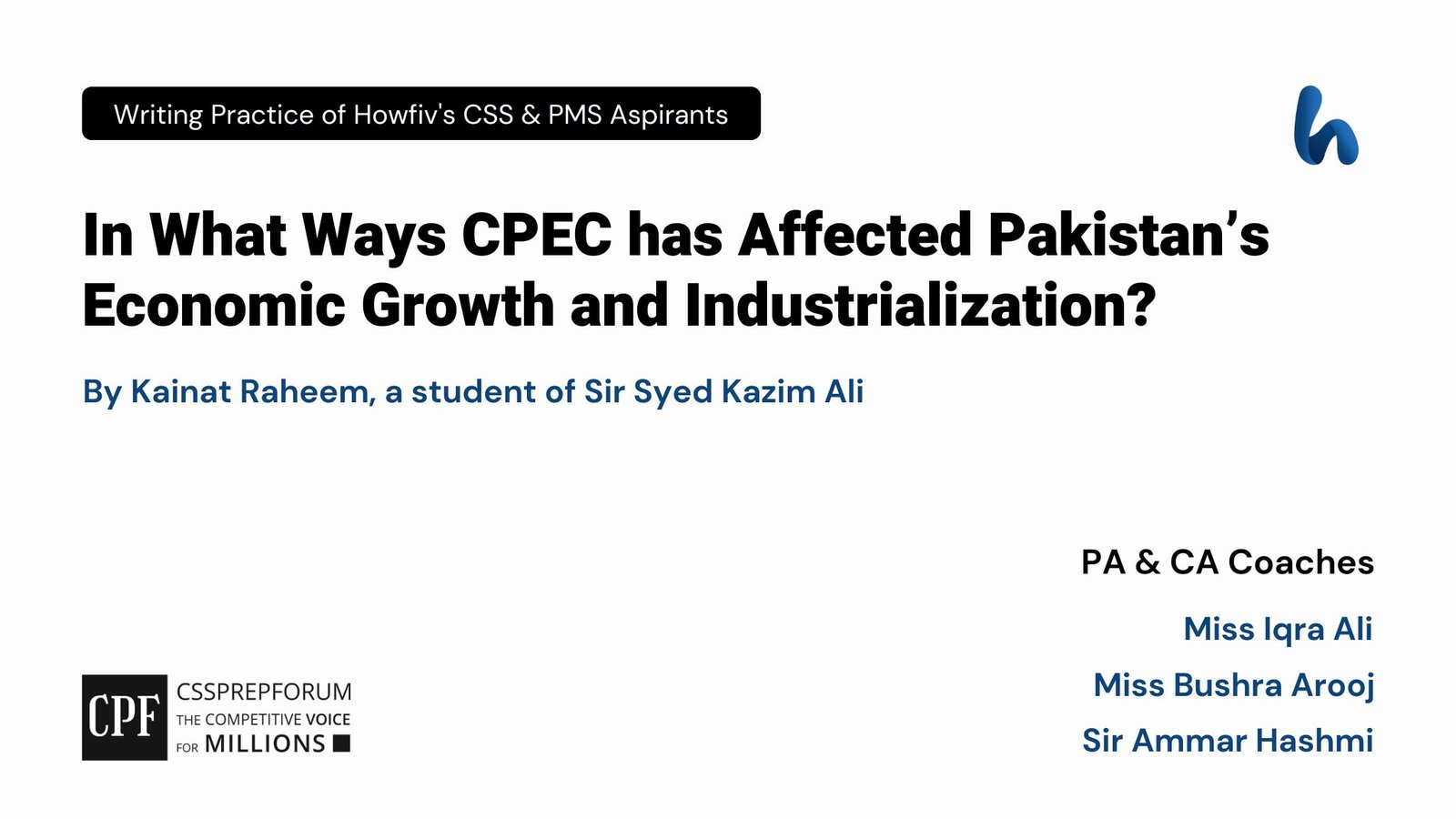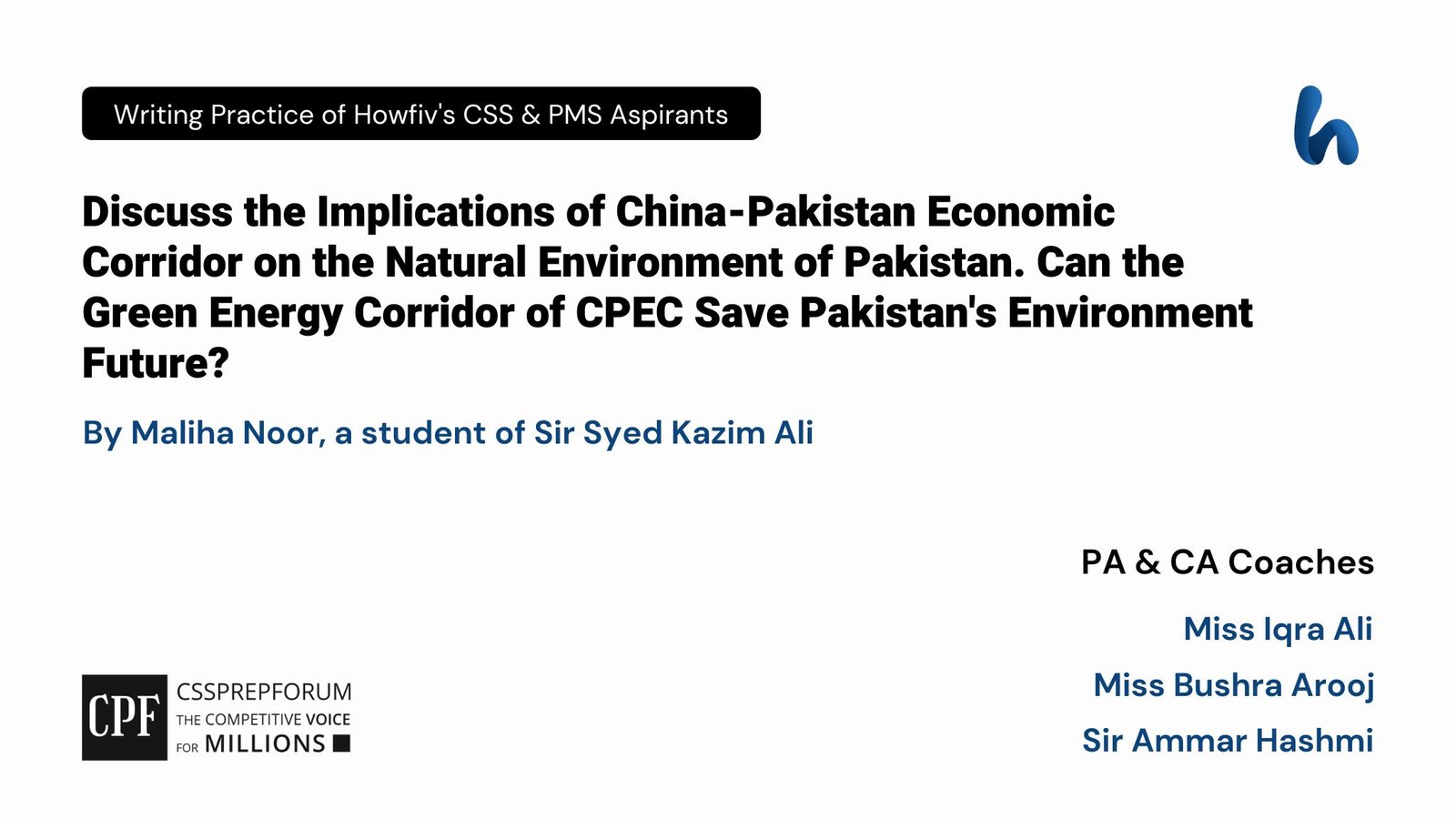CSS 2018 Solved Pakistan Affairs Past Papers | Discuss the Changing Trends in Pakistan-US Relations Since 2001.
The following question of CSS Pakistan Affairs 2018 is solved by Ayesha Irfan on the guided pattern of Sir Syed Kazim Ali, which he taught to his students, scoring the highest marks in compulsory subjects for years. This solved past paper question is uploaded to help aspirants understand how to crack a topic or question, how to write relevantly, what coherence is, and how to include and connect ideas, opinions, and suggestions to score the maximum.

Question Breakdown
The examiner has demanded the changing trends in Pakistan-US relations since 2001. Before touching on the exact requirement, it would be great to cast a spotlight on the Post 2001 relations between Pakistan and the U.S. Then, the diverse aspects of the changing trends in relations between these two states will be presented.
Outline
1- Introduction
- Since 1947 till the present, there have been ups and downs in Pakistan-US ties. After the 9/11 attacks in 2001, Pakistan unquestionably became a significant ally in the United States’ combined war on terrorism. From the age of alliances to the apparent hostility and apathy, the changing dynamics of US-Pakistan relations must be analyzed from a practical standpoint where power, national interests, security, and sovereignty matter.
2- Post-2001 relations between Pakistan and U.S.
3- What are the changing trends in Pakistan-US relations since 2001?
- ✓ The era of alliance from 2001-2004
- ✓ The event of Libya and U.S. aid jolted the relations from 2005-2007
- ✓ The rejection of the Kerry Luger bill and trust deficit issues from 2008-2010
- ✓ The era of frustration in Pakistan’s establishment against the U.S. from 2011-2013
- ✓ The era of rapprochement from 2014-2015
- ✓ The era of pressurized Pakistan to do more from 2016-17
- ✓ The era of a reset in the bilateral relationship from 2018-2019
- ✓ The era of uncertain doldrums from the 2020 date
4- Conclusion

Introduction
Pakistan-US relations have had ups and downs since 1947 till now. The shifting dynamics of Pakistan-US ties, from the era of alliances to the apparent animosity and apathy, must be examined from a pragmatic point of view where power, national interests, security, and sovereignty matter. Furthermore, the political, security, economic, and power dynamics of ties between Pakistan and the United States continue to be influenced by mistrust, suspicions, animosity, and paranoia. Undoubtedly, Pakistan became a crucial partner in the joint fight on terror with the United States following the September 11 attacks in 2001. Nevertheless, American President George W. Bush persuaded the government to join the fight against terrorism. However, the fight against terrorism has also led to a number of inconsistencies that have strained and sometimes sprung conflicts in the two nations’ ties. Nonetheless, the US-Pakistan relationship, which is still in its infancy, has the potential to develop into a solid alliance that will help to bring stability, prosperity, and peace throughout South Asia.
A glance at post-2001 relations between Pakistan and the U.S.
Pakistan and the U.S. established diplomatic ties in 1947. The U.S.’s decision to back Pakistan militarily and economically, as well as Pakistan’s membership in the CENTO and SETO organizations, strengthened the diplomatic connections between these two nations. However, the U.S. ceasing its military support to Pakistan in 1965, 1971, and 1975 led to a widespread perception in Pakistan that the US was an unreliable partner. Except for this, Under the Foreign Assistance Act, the United States cut off the majority of Pakistan’s financial support in April 1979 due to concerns about that country’s atomic weapon effort. However, the Soviet invasion of Afghanistan in 1979 brought to light Pakistan’s and the United States’ shared interest in stability and peace in South Asia.
What are the changing trends in Pakistan-US relations since 2001?
Since 2001, there has been an improvement in ties between the U.S. and Pakistan. They cooperated and got along well on a variety of issues. In order to understand how US-Pakistan relations have changed since 2001, it is required to classify these relationships into the following areas.
- ✓ From 2001-2004; the era of alliance
After the 9/11 incidents, Pakistan became an important ally of the U.S. in the war against terror. However, George W. Bush, the president of the United States, pushed the government to join the war on terror in 2001. Pervez Musharraf writes in his book, “We’ve captured 689 and handed over 369 to the United States,” about the payment he received for terrorists he had detained. Therefore, Pakistan got around $10 billion in U.S. aid since 2001, largely in the form of military assistance, in exchange for their cooperation, which led to the lifting of sanctions. President George W. Bush recognized Pakistan as a significant non-NATO partner in June 2004, granting it access to, among other things, cutting-edge American military equipment. Powell said. “It is about the rebirth of a long-term partnership between the two countries.”.
- ✓ From 2005 to 2007, the event of Libya and U.S. aid jolted the relations
Unfortunately, Pakistan was caught in the act in 2006 when it attempted to give Libya the whole component of a nuclear weapon manufacturing facility. It led to a direct conflict between Pakistan and the U.S. Further, in a report published in 2007, Pakistan was charged with utilizing aid funds supplied by the U.S. for its cooperation in the fight against terrorism to bolster its defences against India. Except for these, According to claims made by Western authorities, the Pakistani military received funding from 2002 to 2007 in an amount of around $3.4 billion that was misappropriated. Therefore, these events jolted the relations between Pakistan and the U.S.
- ✓ From 2008 to 2010, the rejection of the Kerry Luger bill and trust deficit issues
NSA Director Mike McConnell addressed ISI Director Ahmad Shuja Pasha in 2008, alleging that the ISI was letting jihadists know about impending American assaults on them so that they could flee. Furthermore, after the assaults in Mumbai in November 2008, the United States notified Pakistan that it anticipated complete cooperation in the search for the attackers. Lawmakers in the Pakistani Parliament made serious accusations against the Americans for doing little to control the porous eastern border of Afghanistan, where terrorists were hiding. After that, Kerry Lugar’s measure, which offered Pakistan’s civil sector $7.5 billion over five years at $1.5 billion per year, was approved by the Obama administration in October 2009. The military rejected it, further deteriorating the relations of both countries.
- ✓ From 2011 to 2013, the era of frustration in Pakistan’s establishment against the US
A string of events in 2011 led to a deterioration in US-Pakistan ties. To start with, a CIA operative named Raymond Davis murdered two guys in Lahore in January 2011. In addition, a covert American operation killed Osama bin Laden from inside Pakistan in May 2011, infringing on Pakistan’s sovereignty. Moreover, in November 2011, NATO forces attacked Pakistan’s Salala military checkpoint, which resulted in the deaths of about 24 Pakistani soldiers. Although it was allegedly an accident, it further deteriorated US-Pak ties, consequently creating frustration in Pakistan’s establishment against the U.S. After it, the China-Pakistan Economic Corridor (CPEC) was launched in 2013 as Pakistan developed relations with China. Pakistan thereby switched its allegiance from the U.S. to China. As a result, Pakistan’s ties with the U.S. were atrocious throughout this time.
- ✓ From 2014 to 2015; the era of rapprochement
In 2014, Ashraf Ghani was eager to have a discourse to resolve the Afghan problem. The then government and Chief of Army Staff were eager to set up negotiations between the U.S. and Afghan Taliban. The agreement was straightforward; Pakistan would bring the Afghan Taliban to the negotiating table, and Afghanistan would wage a fierce campaign against the TTP commanders who were hiding within Afghanistan and creating havoc in Pakistan from there. The meetings were planned for 2015. Consequently, the U.S. and Pakistan’s shared interests once more pulled them together.
- ✓ From 2016 to 2017, the era of pressurized Pakistan to do more
Trump’s Afghan policy, however, remained completely in opposition. In addition to giving the go-ahead for additional American forces, he also put Pakistan under pressure to step up its efforts in 2017. He boosted India’s participation in Afghanistan, which only served to worsen the situation. His approach was to “Stay and Fight.” Moreover, Donald Trump blasted Pakistan once more on January 1, 2018, claiming, “They have given us nothing but lies and deceit”. As a result of Pakistan’s unwillingness to take decisive action against Afghan Taliban insurgents and their safe havens there, President Trump announced the cancellation of a $300 million transfer to Pakistan. The U.S.’s new Afghan strategy ran counter to Pakistan’s objectives.
- ✓ From 2018 to 2019, the era of a reset in the bilateral relationship
In 2019, former Prime Minister Imran Khan visited the U.S. and met with President Trump; after that visit, bilateral ties between the two nations improved. The visit of Khan to the United States was seen by many observers as a “reset” in the bilateral ties between the two nations. Due to the fact that the United States is Pakistan’s top export market, President Trump called for a significant strengthening of the two countries’ economic ties. Additionally, President Trump promised to arbitrate the Kashmir conflict between India and Pakistan. But the Indian foreign office rejected Trump’s offer right away.
- ✓ From 2020 to date; the era of uncertain doldrums
On the fringes of the World Economic Forum in Davos in January 2020, Prime Minister Khan and President Trump once more met. President Trump praised the improvement in ties between the U.S. and Pakistan. However, After American soldiers left Afghanistan in 2021, the U.S. ‘clearly distanced’ itself from Pakistan, with Imran Khan praising Afghans for escaping “the shackles of slavery”.The Biden administration’s ‘Summit for Democracy’ in the U.S. was extended an invitation, but Pakistan denied it.
Furthermore, U.S. President Joe Biden referred to Pakistan as “one of the most dangerous nations in the world” in October 2022 when discussing the shifting geopolitical landscape in a speech in California. The Government of Pakistan denounced the assertion as unfounded, and the nation’s acting foreign secretary summoned the American ambassador to demand an explanation of Biden’s comments. Last but not least, the United States and Pakistan’s already-existing geopolitical rivalry is exacerbated by strategic competition between China and the United States.
Conclusion
Undoubtedly, Pakistan supported the U.S. in the “War on Terror” and became its most crucial partner after 9/11; their ties remained strained and had hard patches as a result of their divergent interests in several areas. However, Biden’s administration is anticipated to usher in a new era in US-Pakistani ties. One might anticipate a move from geopolitics to microeconomics, soft power, and information technology, although the core tenets of American policy towards Pakistan would stay unaltered, emphasizing Islamabad’s role in peace in Afghanistan and in the South Asian region.
CSS 2018 Solved Pakistan Affairs
CSS Solved Past Papers’ Essays
Looking for the last ten years of CSS and PMS Solved Essays and want to know how Sir Kazim’s students write and score the highest marks in the essays’ papers? Then, click on the CSS Solved Essays to start reading them.
CSS Solved Essays
CSS Solved General Science & Ability Past Papers
Want to read the last ten years’ General Science & Ability Solved Past Papers to learn how to attempt them and to score high? Let’s click on the link below to read them all freely. All past papers have been solved by Pakistan’s top CSS GSA coach having the highest score of their students.
General Science & Ability Solved Past Papers












